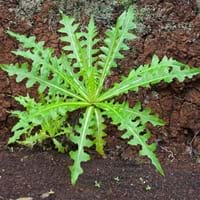Life Span
Perennial
Annual
Origin
Not Available
Europe
Types
Not Available
Not Available
Habitat
Forests, gardens, Hill prairies, Homesteads, Rocky areas, Woodlands
Cultivated Beds, Waste areas
USDA Hardiness Zone
Not Available
6-9
AHS Heat Zone
Not Available
Not Available
Sunset Zone
Not Available
Not Available
Habit
Bushy, Evergreen
Clump-Forming
Minimum Height
Not Available
Minimum Width
Not Available
Flower Color
Light Green, Lime Green
Yellow
Flower Color Modifier
Not Available
Bicolor
Fruit Color
Green, Light Green
White
Leaf Color in Spring
Yellow, Green, Gray Green
Light Green, Gray Green
Leaf Color in Summer
Light Green
Light Green, Gray Green
Leaf Color in Fall
Yellow, Green, Gray Green
Not Available
Leaf Color in Winter
Yellow, Green, Gray Green
Light Green
Leaf Shape
Ovate
Arrowhead
Plant Season
Spring, Summer, Fall, Winter
Not Available
Sunlight
Full Sun, Partial Sun, Partial shade
Full Sun, Partial Sun
Growth Rate
Fast
Very Fast
Type of Soil
Loam, Sand
Clay, Loam, Sand
The pH of Soil
Acidic, Neutral, Alkaline
Acidic, Neutral, Alkaline
Soil Drainage
Well drained
Average
Bloom Time
Early Summer, Summer, Late Summer, Early Fall
Late Spring, Early Summer
Tolerances
Pollution, Salt, Soil Compaction
Drought
Where to Plant?
Ground
Ground
How to Plant?
Seedlings, Stem Cutting, Stem Planting
Seedlings
Plant Maintenance
Low
Medium
Watering Requirements
Keep ground moist, Requires regular watering, Use Mulches to help prevent water loss during hot and windy weather
Requires regular watering
In Summer
Lots of watering
Lots of watering
In Spring
Moderate
Moderate
In Winter
Average Water
Average Water
Soil pH
Acidic, Neutral, Alkaline
Neutral
Soil Type
Loam, Sand
Moist
Soil Drainage Capacity
Well drained
Well drained
Sun Exposure
Full Sun, Partial Sun, Partial shade
Full Sun
Pruning
Cut or pinch the stems, Do not prune during shooting season, Remove deadheads
Remove damaged leaves, Remove dead branches, Remove dead leaves
Fertilizers
High Potash Fertilizer
All-Purpose Liquid Fertilizer
Pests and Diseases
Bacterial Blight, Foliage-feeding caterpillars, Moth
Red blotch
Plant Tolerance
Pollution, Salt and Soil Compaction
Drought
Flower Petal Number
Single
Single
Foliage Texture
Fine
Medium
Foliage Sheen
Matte
Matte
Attracts
Caterpillar
Butterflies
Allergy
Skin irritation
Not Available
Aesthetic Uses
Not Used For Aesthetic Purpose
Showy Purposes
Beauty Benefits
Blood purifying, Glowing Skin, Good for skin and hair, Provides herbal hair care, Speed hair growth
Not Available
Environmental Uses
Air purification, soil stabilisation
Air purification
Medicinal Uses
Atherosclerosis, Cancer, Diabetes, Diarrhea, High blood pressure, High cholestrol, Obesity, Vitamin C
Anxiety, Cough, Insomnia, Rheumatism, Wounds
Part of Plant Used
Fruits
Flowers, Leaves
Other Uses
Making Shampoo, Used for its medicinal properties, Used in herbal medicines
Showy Purposes
Used As Indoor Plant
No
No
Used As Outdoor Plant
Yes
Yes
Garden Design
Cottage garden
Not Available
Botanical Name
Phyllanthus emblica
LACTUCA serriola
Common Name
Indian Gooseberry, Amla , Awala
Compass Plant, Horse Thistle, Prickly Lettuce
In Hindi
आमला
Prickly Lettuce
In German
Stachelbeere
Feigensalat
In French
Groseille à maquereau
laitue scariole
In Spanish
Grosella
lechuga espinosa
In Greek
Φραγκοστάφυλλο
φραγκοσυκιές Μαρούλι
In Portuguese
Groselha
alface espinhosa
In Polish
Agrest
Kolczasta Sałata
In Latin
hominem
Opuntia Lactuca
Phylum
Magnoliophyta
Magnoliophyta
Class
Magnoliopsida
Magnoliopsida
Order
Malpighiales
Asterales
Family
Phyllanthaceae
Asteraceae
Genus
Phyllanthus
Lactuca
Clade
Angiosperms, Eudicots, Rosids
Angiosperms, Asterids, Eudicots
Tribe
Phyllantheae
Cichorieae
Subfamily
Not Available
Not Available
Number of Species
Not Available
Not Available
Season and Care of Indian Gooseberry and Prickly Lettuce
Season and care of Indian Gooseberry and Prickly Lettuce is important to know. While considering everything about Indian Gooseberry and Prickly Lettuce Care, growing season is an essential factor. Indian Gooseberry season is Spring, Summer, Fall and Winter and Prickly Lettuce season is Spring, Summer, Fall and Winter. The type of soil for Indian Gooseberry is Loam, Sand and for Prickly Lettuce is Clay, Loam, Sand while the PH of soil for Indian Gooseberry is Acidic, Neutral, Alkaline and for Prickly Lettuce is Acidic, Neutral, Alkaline.
Indian Gooseberry and Prickly Lettuce Physical Information
Indian Gooseberry and Prickly Lettuce physical information is very important for comparison. Indian Gooseberry height is 800.00 cm and width 400.00 cm whereas Prickly Lettuce height is Not Available and width Not Available. The color specification of Indian Gooseberry and Prickly Lettuce are as follows:
Indian Gooseberry flower color: Light Green, Lime Green
Indian Gooseberry leaf color: Yellow, Green and Gray Green
Prickly Lettuce flower color: Yellow
- Prickly Lettuce leaf color: Light Green and Gray Green
Care of Indian Gooseberry and Prickly Lettuce
Care of Indian Gooseberry and Prickly Lettuce include pruning, fertilizers, watering etc. Indian Gooseberry pruning is done Cut or pinch the stems, Do not prune during shooting season and Remove deadheads and Prickly Lettuce pruning is done Remove damaged leaves, Remove dead branches and Remove dead leaves. In summer Indian Gooseberry needs Lots of watering and in winter, it needs Average Water. Whereas, in summer Prickly Lettuce needs Lots of watering and in winter, it needs Average Water.





